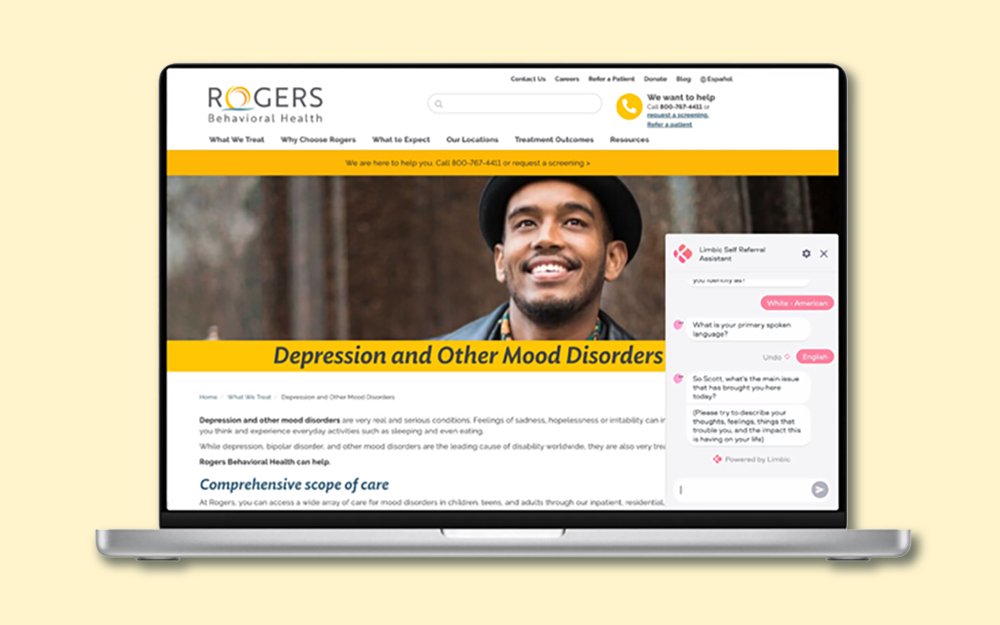
Focusing in on telehealth: How it’s grown and what comes next
09/19/24 01:30:pm
Telehealth may have first seen its rise during the pandemic, but it’s here to stay – and expanding at Rogers – for good reason.
“During the COVID pandemic, we tried to pivot to virtual care as quickly as we could to maintain treatment for our patients,” says Greg Wisniewski, associate director for Telehealth Operations. “We saw great innovation and increased accessibility. Now, we have the opportunity to implement a more deliberate growth plan and continue expanding access to our care.”
Rogers’ telehealth team has been busy redesigning the virtual care programming and working to expand. This Telehealth Awareness Week, Sept. 15-21, we’re giving you a closer look at how Rogers approaches virtual care and our plans for the future.
Expansion and plans for growth
Rogers now offers telehealth services in Wisconsin, Illinois, Minnesota, Tennessee, Florida, and Colorado. In early 2024, Rogers began to transition from site-based telehealth to statewide telehealth by bringing each of the 100% virtual programs and remote teams under one umbrella—the Telehealth division. A priority in 2024 has been having the team pursue cross-state licensure.
Cross-state licensure has already allowed Rogers teams to become more regionally based, allowing Tennessee and Minnesota teams to support each other and Wisconsin and Illinois teams to do the same. This is allowing statewide-based telehealth to become interstate telehealth programming, enabling teams to work together to support patients and pivot to where the needs are. The overall goal is to continue this interstate model so we can eventually serve patients in all 10 states where we operate.
Other expansions include the fully virtual Fire Watch program for Veterans and service members which launched in early September.
“We’re also working on expanding care in a variety of other ways, trying to explore other populations of people who may have trouble getting access to treatment,” Greg says.
Program redesign
First rolled out in Minnesota on July 1, Rogers began taking a more individualized approach to virtual care that follows a college model.
“We have given patients core groups, and everyone participates in something like college general education classes. Based on their individual needs, they have symptom-specific groups. For example, they could be attending depression-specific groups, Primary Behavioral Health-specific groups, or OCD-specific groups. We’re able to support a range of individuals and really treat for individual symptoms.”
Much like our geographical flexibility from cross-state licensure, this individualized approach to care allows us to pivot to support the changing needs of our communities and diverse patient populations.
Rogers is also collaborating with Class to offer our treatment on a new virtual platform, which is interactive and tailored to patients’ specific needs. It’s used for all our 100% virtual programs.
“It allows us to really streamline the process. On Teams patients had multiple links. Class is just one,” Greg says. “It’s designed for learning, which aligns well with how we approach our treatment. It is still the same Rogers care. It’s all evidence-informed and based in our protocols.”
In addition to the adult care we already provide virtually, the team would like to expand telehealth treatment to children and adolescents.
Addressing myths
“A lot of people think telehealth is second class and is only for those who don’t have access to an in-person location, live in a rural area, or don’t have a car. That’s not true,” she says. “There are a lot of reasons why people would prefer virtual care, and studies consistently show it’s just as effective as traditional therapy for conditions like anxiety, depression, substance abuse, and PTSD.”
“The treatment continues to be patient-centered and provides evidence-informed care just as in-person does,” says Courtney Evans, telehealth outreach coordinator. “You’re still getting the quality of treatment that Rogers is known for, we are just changing the setting to provide increased accessibility and convenience. We are giving patients options to meet them where they are.”
Telehealth benefits
Meeting patients where they are has taken on a literal meaning now that virtual care allows treatment from the comfort of home.
“There’s a lot of convenience associated with telehealth,” Greg says. “Also, from a clinical perspective, the ability to do exposures in someone’s home environment is so valuable. Things like doing laundry or dishes can seem overwhelming, but having one of our clinicians talk a patient through that is something that telehealth facilitates well.”
“Virtual care allows providers to be more mindful of the patient’s life outside of care,” says Courtney. “It’s also cost-effective, because patients don’t have to get childcare, travel somewhere, or take time off of work.”





